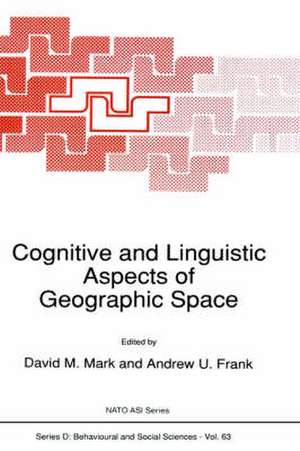Cognitive and Linguistic Aspects of Geographic Space: NATO Science Series D:, cartea 63
Editat de D.M. Mark, Andrew U. Franken Limba Engleză Hardback – 30 noi 1991
| Toate formatele și edițiile | Preț | Express |
|---|---|---|
| Paperback (1) | 1826.69 lei 6-8 săpt. | |
| SPRINGER NETHERLANDS – 16 oct 2012 | 1826.69 lei 6-8 săpt. | |
| Hardback (1) | 1833.02 lei 6-8 săpt. | |
| SPRINGER NETHERLANDS – 30 noi 1991 | 1833.02 lei 6-8 săpt. |
Din seria NATO Science Series D:
- 18%
 Preț: 1223.25 lei
Preț: 1223.25 lei -
 Preț: 399.88 lei
Preț: 399.88 lei -
 Preț: 398.74 lei
Preț: 398.74 lei - 18%
 Preț: 953.35 lei
Preț: 953.35 lei -
 Preț: 389.88 lei
Preț: 389.88 lei - 18%
 Preț: 1230.53 lei
Preț: 1230.53 lei -
 Preț: 399.29 lei
Preț: 399.29 lei - 18%
 Preț: 953.35 lei
Preț: 953.35 lei - 18%
 Preț: 1226.90 lei
Preț: 1226.90 lei - 5%
 Preț: 390.13 lei
Preț: 390.13 lei - 5%
 Preț: 370.94 lei
Preț: 370.94 lei -
 Preț: 412.95 lei
Preț: 412.95 lei - 18%
 Preț: 1224.18 lei
Preț: 1224.18 lei - 15%
 Preț: 480.20 lei
Preț: 480.20 lei -
 Preț: 412.95 lei
Preț: 412.95 lei - 18%
 Preț: 1226.73 lei
Preț: 1226.73 lei - 5%
 Preț: 2124.15 lei
Preț: 2124.15 lei - 15%
 Preț: 638.11 lei
Preț: 638.11 lei - 18%
 Preț: 1833.16 lei
Preț: 1833.16 lei -
 Preț: 401.24 lei
Preț: 401.24 lei -
 Preț: 390.84 lei
Preț: 390.84 lei - 18%
 Preț: 1237.80 lei
Preț: 1237.80 lei - 18%
 Preț: 1826.69 lei
Preț: 1826.69 lei - 18%
 Preț: 1830.34 lei
Preț: 1830.34 lei -
 Preț: 388.13 lei
Preț: 388.13 lei - 18%
 Preț: 948.47 lei
Preț: 948.47 lei - 18%
 Preț: 1835.53 lei
Preț: 1835.53 lei - 18%
 Preț: 1227.67 lei
Preț: 1227.67 lei - 18%
 Preț: 1225.79 lei
Preț: 1225.79 lei -
 Preț: 398.53 lei
Preț: 398.53 lei - 18%
 Preț: 1831.73 lei
Preț: 1831.73 lei -
 Preț: 396.24 lei
Preț: 396.24 lei - 18%
 Preț: 1661.13 lei
Preț: 1661.13 lei
Preț: 1833.02 lei
Preț vechi: 2235.39 lei
-18% Nou
Puncte Express: 2750
Preț estimativ în valută:
350.74€ • 366.20$ • 290.29£
350.74€ • 366.20$ • 290.29£
Carte tipărită la comandă
Livrare economică 05-19 aprilie
Preluare comenzi: 021 569.72.76
Specificații
ISBN-13: 9780792315377
ISBN-10: 0792315375
Pagini: 519
Ilustrații: VIII, 519 p.
Dimensiuni: 155 x 235 x 29 mm
Greutate: 0.91 kg
Ediția:1991
Editura: SPRINGER NETHERLANDS
Colecția Springer
Seria NATO Science Series D:
Locul publicării:Dordrecht, Netherlands
ISBN-10: 0792315375
Pagini: 519
Ilustrații: VIII, 519 p.
Dimensiuni: 155 x 235 x 29 mm
Greutate: 0.91 kg
Ediția:1991
Editura: SPRINGER NETHERLANDS
Colecția Springer
Seria NATO Science Series D:
Locul publicării:Dordrecht, Netherlands
Public țintă
ResearchCuprins
Cognitive and Linguistic Aspects of Geographic Space: An Introduction.- Section 1: Geographic Space.- 1.1 Geographic Space as a Set of Concrete Geographical Entities.- 1.2 Some Notes on Geographic Information Systems: The Relationship Between their Practical Application and their Theoretical Evolution.- 1.3 A Hand-In-Glove Paradigm for Geography.- Section 2: Cultural Influences on the Conceptualization of Geographic Space.- 2.1 “Through the Door”: A View of Space from an Anthropological Perspective.- 2.2 Culture as Input and Output of the Cognitive-Linguistic Processes.- 2.3 Dialogic and Argumentative Structures of Bumper Stickers.- Section 3: Wayfinding and Spatial Cognition.- 3.1 The Development of the Abilities Required to Understand Spatial Representations.- 3.2 Making Sense of Human Wayfinding: Review of Cognitive and Linguistic Knowledge for Personal Navigation with a New Research Directioa.- 3.3 Wayfinding Theory and Research: The Need for a New Approach.- 3.4 The Effect of the Pattern of the Environment on Spatial Knowledge Acquisition.- 3.5 Methods for Measuring Spatial Cognition.- 3.6 Path Finding in Free Space Using Sinusoidal Transforms: III.- Section 4: Cartographic Perspectives.- 4.1 Mapping as Language or Semiotic System: Review and Comment.- 4.2 Plan Information and its Retrieval in Map Interpretation: The View from Semiotics.- 4.3 An Approach to Map/Text Interrelationships.- 4.4 Spatial Knowledge for Image Understanding.- Section 5: Formal Treatment of Space in Mathematics.- 5.1 The Mathematical Modeling of Spatial and Non-Spatial Information in Geographic Information Systems.- 5.2 Map Algebra as a Spatial Language.- 5.3 Qualitative Spatial Reasoning.- 5.4 Relative Representation of Spatial Knowledge: The 2-D Case.- 5.5 Matching Representations ofGeographic Locations.- 5.6 The Role of Modal Logics in the Description of a Geographical Information System.- Section 6: User Interfaces and Human-Computer Interaction.- 6.1 A Formalization of Metaphors and Image-Schemas in User Interfaces.- 6.2 Elicitation of Spatial Language to Support Cross-Cultural Geographic Information Systems.- 6.3 UGIX: A Layer Based Model For A GIS User Interface.- 6.4 Deficiencies of SQL as a GIS Query Language.- 6.5 The Role of the User in Generalization within Geographic Information Systems.- 6.6 Virtual Worlds, Inside and Out.- Appendix: NATO Advanced Study Institute Participants.




